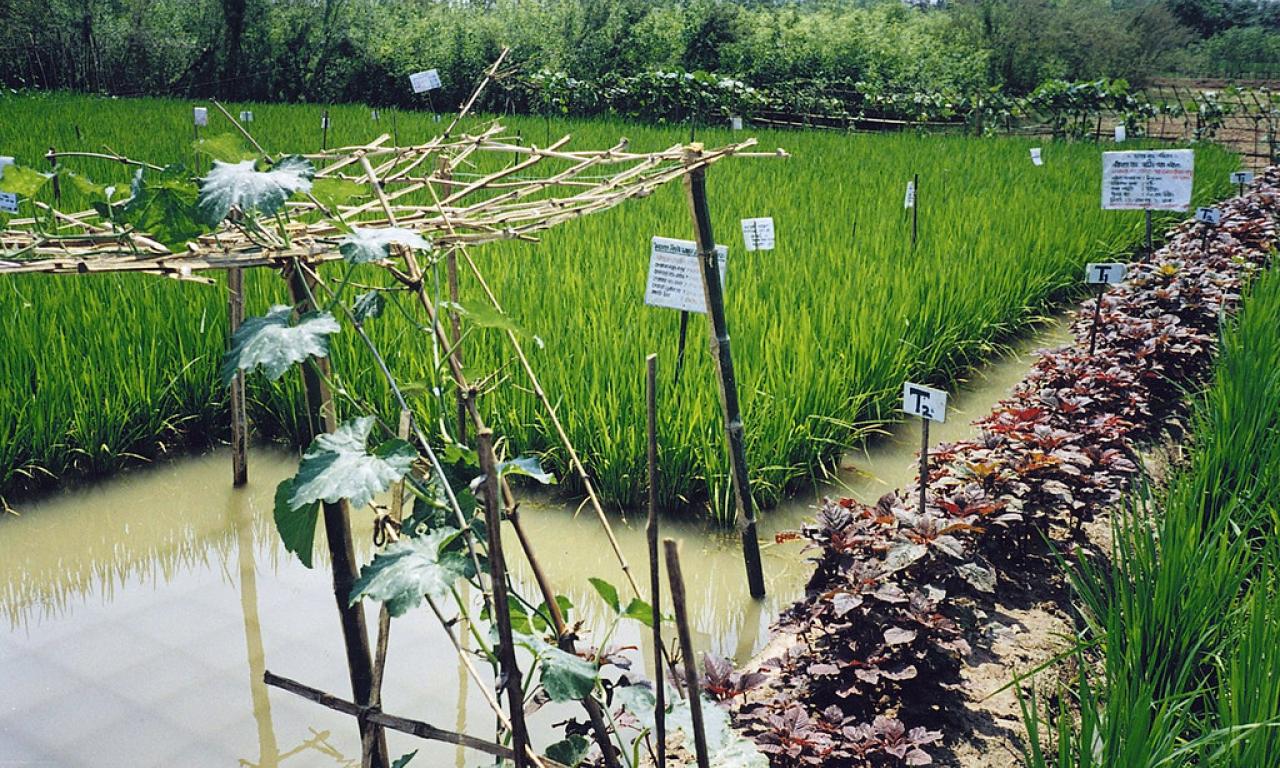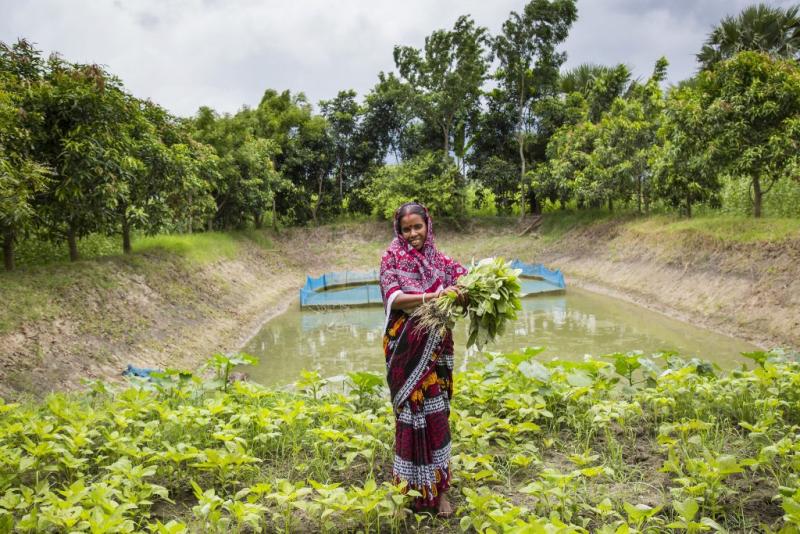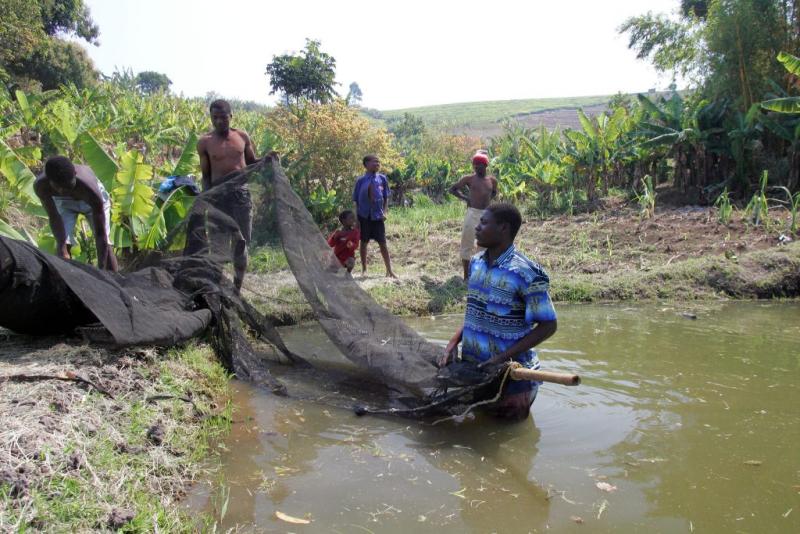
What do catfish and bananas have in common? No, this is not a riddle or the start of a bad joke. Some farmers know the answer: Bananas and catfish are a win-win when grown together in the same farming system. In fact, banana residues are a nutritious feed to enhance the growth of the catfish.
New research shows that in combination they provide a complementary integrated agriculture-aquaculture (IAA) system which can add diversity to diets, provide increased economic opportunity while being good for the environment. The findings have also been published as journal article.
The benefits of integrating rice, livestock or poultry with fish are well documented but there is little research on the advantages of combining fish with roots, tubers and bananas, said Lauren Pincus, a value chains scientist with WorldFish who worked on the study.
“We are looking into the food value chains for combinations that reduce the climate impacts of farming. Aquaculture integrated with roots, tubers and banana production is definitely a topic that needs further exploration,” she said.
IAA systems are environmentally beneficial due to their emphasis on recycling nutrients from crop residues and water through the system. They are positioned as particularly appropriate for small-scale, resource-poor farmers and suitable for areas with limited availability of agricultural land.
Researchers from the CGIAR Research Programs on Fish Agri-Food Systems (FISH) and on Roots, Tubers and Bananas (RTB) teamed up to investigate what is currently known about IAA systems that comprise both fish and other aquatic animals, and RTB crops. Despite the potential benefits, the review of the literature found just nine scientific studies assessing the benefits of integrated fish and RTB crops systems but provided a great start in exploring a food-based approach to farming.
“We are trying to address our food system challenges by looking into the animal or crop production value chains and minimising food waste and loss,” added Diego Naziri, co-author and value chain and post-harvest specialist with the International Potato Center (CIP). “Our aim in this study was to document links among fish and roots, tubers and banana crops within agri-food systems and identify opportunities for strengthened integration in production systems, animal feed and nutrient-rich food products.”
Roots, tubers and bananas provide an estimated average of 20 percent of the daily per capita calorie intake for the 640 million inhabitants of sub-Saharan Africa and are an important staple in in lower-income countries. With the growing population there is increasing demand for these crops both for food and for feed. Similarly, 3.2 billion people worldwide rely on fish for almost 20 percent of their animal source food intake. Their combination in IAA farming benefits smallholder farmers who can consume and have access to both vegetable and animal source foods.
“When households have the opportunity to consume fish and root, tuber and banana crops together in the same meal, they can also realize the additional nutritional benefit that comes from consuming an animal-source food that improves the nutrient bioavailability of the staple food on their plate,” said Kendra Byrd, WorldFish nutrition scientist.
The research underscores a move to a multi-goal, nutrition-sensitive approach, which utilizes agricultural systems to advance food security, malnutrition and poverty objectives. Nutrition-sensitive interventions are referred to as “food-based” approaches that aim to address the underlying determinants of micronutrient deficiencies—meaning access to and adequate consumption of a variety of nutritious and safe to consume foods.
“Globally, banana was the RTB crop most commonly integrated with fish production. Farmers reported taking advantage of the pond water to produce RTB crops and using the pond silt as fertilizer for the crops,” said Molly Atkins, leading author of the review.
“The peels and leaves of the crops could also be used as feed for the fish, particularly by smallholder farmers who find commercially-produced fish feed prohibitively expensive,” she explained.
“Further research that looks into how developing country agricultural systems can use ‘circular economy’ concepts, such as diverting cassava peel to fish feed mills, to increase nutrient cycling and reduce waste throughout the systems would be beneficial.” she added.
Harnessing nutrients from what might be considered agricultural ’waste’ is expected to reduce the need for commercial fertilizers, which are commonly applied to ponds to serve the same phytoplankton-producing function.

The study found much detail on how farmers harnessed the nutrient- and water-cycling benefits of IAA systems, in subsequent interviews with stakeholders in Bangladesh. However, farmers in Bangladesh reported that they saw IAA practices declining over time, and some attributed this to extension officers discouraging farmers from using ‘traditional’ IAA practices.
The review also found thirty studies investigating root, tuber and banana crop residues to determine their feasibility as an ingredient in commercially-produced fish feed. Many of these studies were conducted in Nigeria, where cassava is widely consumed and there is a growing aquaculture sector. Fish feed is often cited as the biggest production cost for fish farmers and lowering the cost of fish feed through the use of locally-available agricultural waste products, such as cassava peel could boost aquaculture, especially in the small-scale sector. Using cassava peel as fish feed could potentially mitigate a growing environmental problem of agricultural waste in Nigeria. The review noted that supply issues would need to be addressed before cassava peel and other RTB crops by-products could be used at a large scale by fish feed mills.
“There is significant scope and relevance to expand investigation into this topic because many smallholders who engage in aquaculture are concurrently producing root, tuber and banana crops as a staple food for their households,” said Byrd.

IAA provides important environmental, social, and economic benefits to production systems, and this review is an important starting place to expand the discussion on IAA with fish and other aquatic animals and RTB, however, many knowledge gaps still exist.
“If we keep in mind that our primary goal with agriculture and aquaculture is better nutrition and we have a nutrition-sensitive approach to farming, we can tackle malnutrition as well as sustainability issues,” emphasized Shakuntala Thilsted, WorldFish research program lead in value chains and nutrition.
“More research is needed to better understand how smallholders around the world use IAA systems to increase productivity, enhance their livelihoods and diversify their diets,” she added.
“Collaborations within the CGIAR, the world’s largest network of agricultural research organizations, like this one between FISH and RTB, can contribute to new thinking around how two different agricultural systems can enhance each other within an integrated food systems framework to create greater environmental, economic and nutritional benefits for farmers, value chain actors and consumers,” said Diego Naziri.
"We are pleased with the collaboration with the FISH CRP, it's the kind of integrative thinking for resilience in agri-food systems that we would like to see growing in the transition to One CGIAR," concludes Graham Thiele, Roots Tubers and Bananas program director.
Acknowledgment
The study was conducted as part of the CGIAR Research Program on Fish Agri-Food Systems (FISH) led by WorldFish, together with the CGIAR Research Program on Roots, Tubers and Bananas led by the International Potato Center (CIP). CGIAR research is made possible by our funders. They contribute to a research partnership with direct impact on the livelihoods of the poor.
Authors: Kendra Byrd, Lauren Pincus, Diego Naziri (CIP-Vietnam), and Shakuntala H. Thilsted.